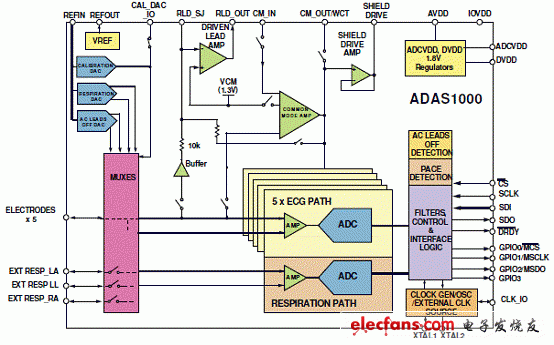ADI's low-power five-electrode electrocardiogram (ECG) system uses the ADAS1000 analog front end (AFE). The ADAS1000 can measure electrocardiogram (ECG) signals, chest impedance, artificial pacing signals, lead connection / drop status, and output this information in the form of data frames, providing lead / vector or electrode data at a programmable data rate. It has low power consumption and small size characteristics, suitable for battery-powered portable applications. This article introduces the main features of ADAS1000, the functional block diagram, and the block diagram of the electrocardiogram (ECG) system solution, the main components used and the main products used in the ECG system.
The ADAS1000 can measure electrocardiogram (ECG) signals, chest impedance, artificial pacing signals, lead connection / disconnection status, and output this information in the form of data frames, providing lead / vector or electrode data at a programmable data rate. It has low power consumption and small size characteristics, suitable for battery-powered portable applications. It is also a high-performance device, so it is suitable for high-end diagnostic equipment.
The ADAS1000 is designed to simplify the task of acquiring and ensuring high-quality ECG signals. Cardiac post-processing is a value-added function that can be executed on an external DSP, microprocessor or FPGA. Multiple digital output options ensure flexibility in monitoring and analyzing signals. ADAS1000 provides a low-power, small-scale data acquisition system for bioelectrical signal applications.
It also has some auxiliary features that help to improve the acquisition quality of ECG signals, including: multi-channel mean driven leads; optional reference drive; fast overload recovery; flexible breathing circuit that returns amplitude and phase information; in 3 leads Connect the built-in pacing signal detection algorithm; and AC or DC lead off detection options.
Because the ECG system is widely used, the ADAS1000 uses a flexible power / noise adjustment option to reduce noise at the cost of increased power consumption. To save power, the signal acquisition channel can be turned off, or the data rate can be reduced.
To simplify manufacturing testing, development, and provide overall power-up testing, the ADAS1000 provides a set of DC and AC test stimuli, CRC redundancy tests, and readback functions for all relevant register address spaces through the CAL DAC.
The ADAS1000 is available in 56-lead LFCSP and 64-lead LQFP packages, and is rated for a temperature range of -40 ° C to + 85 ° C.
ADAS1000 main features
(1) Bioelectric signal input, digital signal output
(2) 5 acquisition (ECG) channels + 1 driven lead
(3) IC can be used for measurement of more than 10 electrodes in parallel
(4) AC and DC lead off detection
(5) Built-in pacing signal detection algorithm in 3 leads
(6)-Support user digital pacing signal
(7) Chest impedance measurement (internal / external path)
(8) Optional reference lead
ADAS1000 application
(1) ECG: monitoring and diagnosis
(2) Bedside patient monitoring
(3) Portable telemetry
(4) Dynamic ECG monitor
(5) Automatic external defibrillator (AED)
(6) Cardiac defibrillator
(7) Portable monitor
(8) Cardiac pacemaker programmer
(9) Patient transport
(10) Stress test

Figure 1. ADAS1000 functional block diagram
Electrocardiogram (ECG) system solution
An electrocardiogram (ECG) system records the electrical activity of the heart over a period of time by measuring the surface potential of living tissue. It uses biopotential electrodes to pick up heart signals from specific parts of the body. The differential voltage between two electrodes or the differential voltage between an electrode and the average voltage of multiple electrodes can be displayed as a channel on the ECG output after measurement.
The main function of the analog front end (AFE) is to digitize the heart signal. Due to the need to suppress interference from strong radio frequency sources, pacing signals, lead-off signals, common-mode frequencies, other muscle signals, and electrical noise, this process is very complicated. Generally, AFE includes instrumentation amplifier (INA), filter and analog-to-digital converter (ADC).
Led Tube light
LED tube is commonly known as light tube, daylight tube, its light source using LED as the luminous body. Led tube has many advantages, using led as the light source, light efficiency is higher, more energy saving, longer service life, and more environmental protection. It is generally used for general lighting, office buildings, shopping malls, restaurants, schools, homes, factories and other Indoor Lighting. LED tube can save more than 70% electricity, and its life is more than 10 times that of ordinary light (in theory, it can reach more than 50,000 hours). It does not need to be replaced frequently. At the same time, LED tube has soft light, pure color, which is beneficial to people's vision protection and health.
LED Fluorescent Light,LED Fluorescent Tube,LED Fluorescent Replacement,LED Tube Light Fixture
JIANGMEN LEDERLIGHT LIGHTING Co.,LTD , https://www.lederlight.com